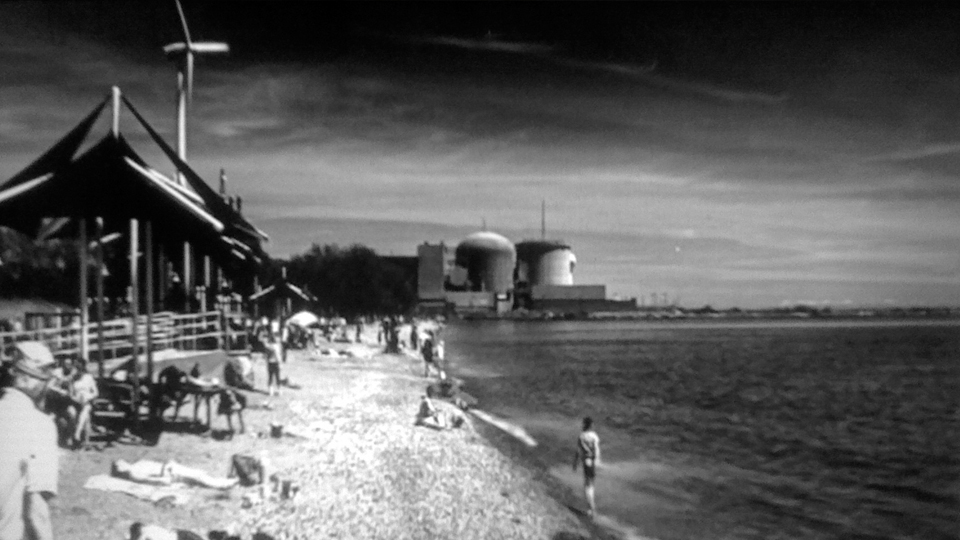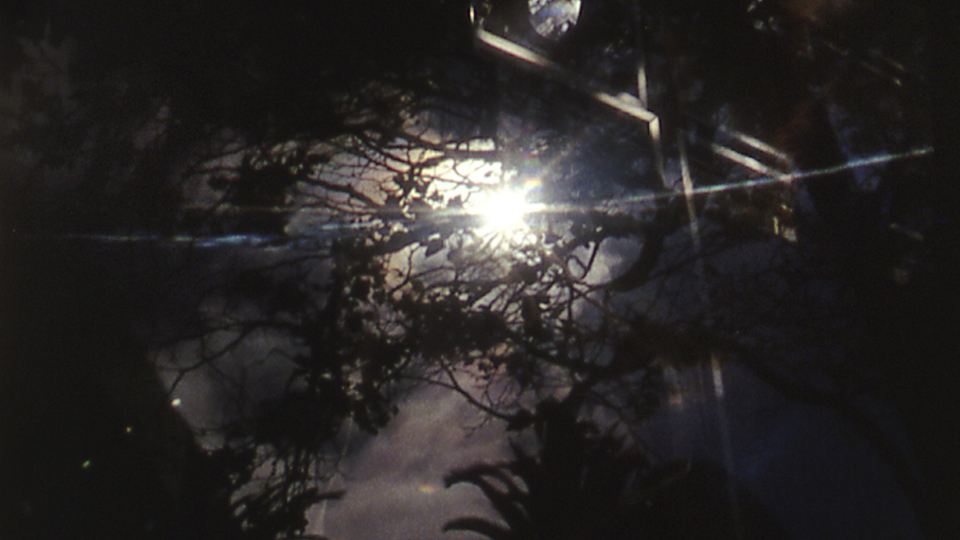 Back to selection
Back to selection
TORONTO 2011: “WAVELENGTHS” PART II
 "Sea Series #10"
"Sea Series #10" 
The adventurous Wavelengths experimental film programs at the Toronto International Film Festival, curated first by Susan Oxtoby and then, in recent years, by Andréa Picard, are a true festival highlight. 2011 was exemplary in this regard, its five experimental programs marked by a diverse range of aesthetics and artistic projects.
An eerie mood pervades the smart, surprising Sea Series #10 by John Price, one of the only films in the 2011 Wavelengths experimental program at the Toronto International Film Festival explicitly inspired by world events. An intertitle explains that the film was made “10,190 km from Fukushima” on May 21, 2011, two months after the deadly Japanese earthquake, tsunami and nuclear disaster, and a week after a leak was reported at the nuclear power plant that lurks just outside Toronto. Located on the shores of Lake Ontario, Pickering is one of the largest nuclear plants in the world. For Price, the date held the added significance of having been designed by a religious group as the day of rapture.
To obtain lush, saturated color, Price develops his 35mm and 16mm footage himself; he also used water from Lake Ontario, the star of Sea Series #10, in that film’s chemical process. The first movement depicts distant sailboats doubling and shifting under a dancing, blue-tinted sun; later shots show tiny dead sardines lapping at the shore, and richly contrasting black-and-white footage of beachgoers at play in Pickering’s ominous shadow.

For James Benning, the formalist behind 2004’s 13 Lakes (thirteen static ten-minute shots of lakes) and 10 Skies (ten static ten-minute shots of the sky), the 99-minute Twenty Cigarettes (2011) is virtually an action movie. Each of the film’s shots (twenty, to mimic the number of smokes in a pack) lasts for the length of a single cigarette as consumed by one of the filmmaker’s friends. The director sees the film as, among other things, a record of the diversity of those who surround him these days and indeed, the ten men (including Thom Andersen, whose Get Out of the Car (2010) made a splash in Wavelengths 2010) and ten women (including Suzan Pitt, whose animated films, like Asparagus (1979), are integral to the experimental film canon) are a mix of ethnicities, ages, colors, shapes and sizes.
Watching a James Benning film, and Twenty Cigarettes in particular, can feel like admiring the emperor’s new clothes. Twenty single takes of people smoking? Surely that’s a cliché of experimental or art house film, one that made your parents plead for you to consider a career in law or medicine. It doesn’t help that Benning shoots his new work on flat digital video, and that while his sense of color and texture are reliably lovely, the same cannot always be said for his visual compositions. (In this realm, he might take a cue from Sadie Benning, co-founder of the band Le Tigre, his daughter, and an impressive filmmaker in her own right).

Yet Twenty Cigarettes is not only maddening, it’s also beguiling, almost in spite of itself. Feeding themselves on smoke, the audience watches the filmmaker’s nearest and dearest dying a tiny breath at a time. They are meditative and thoughtful. Their little ticks emerge and, since they are not identified by name until the film’s credits, come to nearly define them: the licking of lips, the rubbing of noses, the shuffling of feet, the speed of inhale and exhale, the twitch, the fidget, the grimace and the faraway smile sustain this subtle, Warholian game. Indeed, the extremity of its ordinary-ness makes Twenty Cigarettes provocative. In much the way that speech manifests or indexes a person’s aliveness, here smoking makes visible the participants’ breath and affirms their existence, if only for a brief, projected spell. But still… is it wrong for me to wish for beauty and humor? How about Twenty Oysters or Twenty Bowls of Spaghetti next time around?
One of the only times the Wavelengths audience was moved to emit sports fan-like whoops of enthusiasm was after seeing Optra Field VII-IX by T. Marie. A dizzying series of shifting, seemingly black-and-white patterns that use the pixel as a geometric building block, these silent works have evolved since Marie began them in 2006. “The rate of transformation is a result of individual, contiguous pixels changing luminance values based on a 256-grayscale-bit depth model,” she explained of the process that created works that “treat ‘bio-optical feedback’ as medium” and heighten “ones own ability to perceive themselves visually perceiving.” As the pixels’ luminosity changes over time, nearly imperceptibly, the larger patterns they create onscreen slyly change and pulse, too. In a sense, an Optra Field is like the nerdy, uptight cousin of a fractal. Termed “unpleasant” and “disappointing” in post-festival reviews, and Optra Field VII-IX can be difficult to watch (epileptics be warned). Yet in the Wavelengths program, Marie’s work illuminated the theater at the Art Gallery of Ontario with light at once synthetic and painterly.

By contrast, the films of Nathaniel Dorsky (“Nick” to his friends), with their enticing, romantic vision of the natural world, are wonderfully easy on the eyes. Dorsky appeared, Zelig-like, in and around the Toronto International Film Festival’s downtown campus with his 16mm Bolex camera in hand, a model of DIY filmmaking. In The Return (2011), a darkly magical silent film, rainbow lens flares sparkle through the branches of woods that seem enchanted. Using layered compositions, reflections and transparencies in careful compositions that emphasize foreground, middle-ground, and background, Dorsky offers a way of looking at the natural world that suggests he may know something of its half-hidden secrets.
Though shot at standard film speed (twenty-four frames per second), Dorsky’s films are projected at silent film speed, which gives them the calm of minutely-slowed motion. “The projector sounds much nicer at eighteen frames-per-second; there’s less grasping. I also find there’s something very gentle at the flicker,” he explained to the enthusiastic audience who had punctuated the screening of The Return with soft sighs of delight. “Plus, you get more for your money.” Dorsky frequently films familiar environments in and around his home, and went so far as to warn against shooting trips where subsequent nostalgia may cloud a fair assessment of an image’s artistic value. “Going on vacation with a camera–it’s a horrible experience,” he sighed. “Everything collapses under the obsessiveness of acquisition.” While the footage for Dorsky’s most well-known film, Hours for Jerome (1982), was shot over several years, he explained that The Return was made more quickly: “My state of mind last spring is now premiering.” For the Wavelengths audience, that’s one premiere well worth the wait.
Read Toronto 2011: “Wavelengths” Part I.
Special thanks to Katia Houde and Andréa Picard.
Livia Bloom is a film curator and the Director of Exhibition and Broadcast at Icarus Films.
